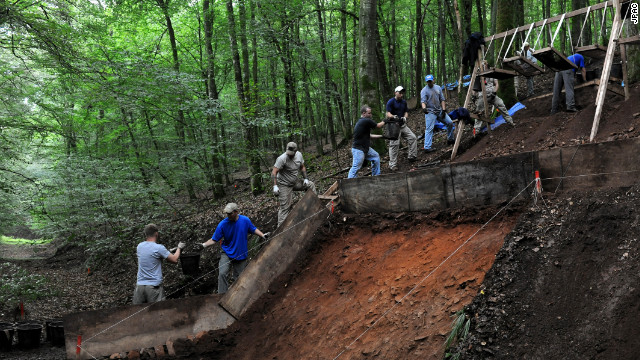
From World War I through the Gulf War, the United States military suffered 631,628 casualties and had 94,416 brave souls missing and unaccounted for. World War II alone accounts for 405,399 of those casualties and 78,978 missing soldiers.
“That is a staggering amount of missing men. And you have to think to yourself, each one of them had a family that loved them.”
Ken Crawford is a 1969 graduate of Wabash College and returned to the Lovell Lecture Room in Baxter Hall to talk about his work to bring home the missing World War II servicemen from battlefields in Europe.
As chief of the Engineering Division for the 21st Theater Support Command, Crawford supported the search and recovery missions by the U.S. Army Memorial Affairs Activity, Landstuhl, Germany, with the Joint POW/MIA Accounting Command throughout Europe, from 1997 through 2002.
Through specific examples of excavations that he was a part of, Crawford detailed the process of recovering a missing soldier even five decades after his death.
“First there is the investigation, which can get very interesting. Often times we receive tips from locals who can still recall the plane crashes and point out where they went down,” he said, adding that many of the tips come from people searching for American .50 caliber guns or scrap metal from the engines.
The next step is search and recovery, which can take a very long time. First they need to identify the type plane by way of serial numbers and then hopefully find the tail number. That should be able to give them a list of the flight crew and narrow their search down.
“It’s a very methodical process, digging in four by four squares one foot deep at time.”
Archaeologists, engineer and translators run the dig, but much of the heavy lifting and sifting is done by special forces units.
One example Crawford gave was of three American soldiers who all died in their foxhole in Belgium. They appeared to take mortar fire and the Germans simply covered their foxhole when they marched through.
Once their bodies were identified, the families of the soldiers decided to have them buried together in a cemetery in Belgium.
“They died together, so we buried them together,” Crawford said. “It was a beautiful ceremony.”
Another example, also in Belgium, was of a pilot who went down with his P-38. The surviving brother of the pilot was at the site, and when the team recovered the pilot’s Second Lieutenant bars, they presented the brother with them in a small ceremony.
“That was really touching to see.”
There are 146 national cemeteries, including Arlington Cemetery in Washington D.C. and the Normandy American Cemetery in France. Crawford said men he helped recover have been laid to rest in many of them. Many cemeteries have a wall of the missing; the wall in Normandy contains 1,500 names alone.
“Whenever we recover a body and lay him to rest, his name receives a rosette next to it which signifies he’s been recovered.”
Through his talk it was apparent that although it was a dirty job at times, Crawford took joy in the bright moments. He gave one surviving airman a piece of his recovered B-17 bomber that crashed over Germany after the pilot flew too low and he presented a farmer in Romania with a helmet, a rifle and bayonet that were uncovered with the body of an American soldier in his garden once the investigation was through.
“It is a long and difficult trail to find everyone. We were lucky to find as many as we did,” Crawford said in his closing. “There are so many guys that went missing. That’s just a fact of war. But the important thing is this — the Department of Defense is still searching.”
Friday 22 March 2013
http://www.journalreview.com/news/article_fdf1bc58-928e-11e2-be06-0019bb2963f4.html

0 comments:
Post a Comment